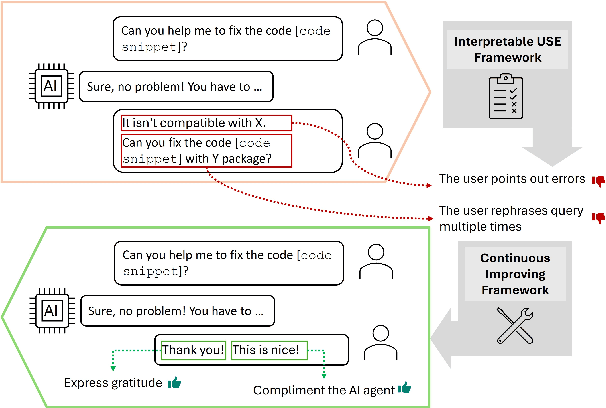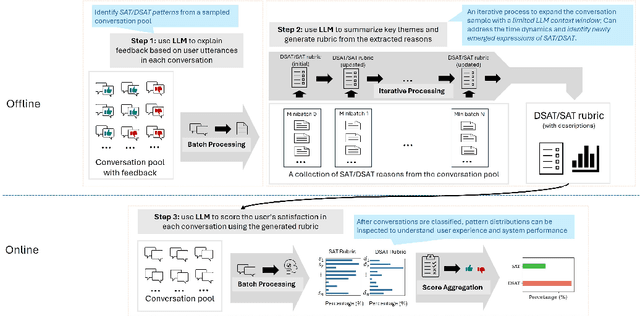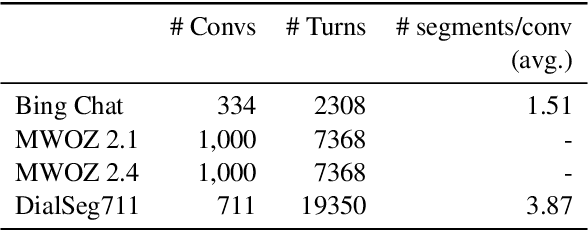Reid Andersen
Interpretable User Satisfaction Estimation for Conversational Systems with Large Language Models
Mar 19, 2024



Abstract:Accurate and interpretable user satisfaction estimation (USE) is critical for understanding, evaluating, and continuously improving conversational systems. Users express their satisfaction or dissatisfaction with diverse conversational patterns in both general-purpose (ChatGPT and Bing Copilot) and task-oriented (customer service chatbot) conversational systems. Existing approaches based on featurized ML models or text embeddings fall short in extracting generalizable patterns and are hard to interpret. In this work, we show that LLMs can extract interpretable signals of user satisfaction from their natural language utterances more effectively than embedding-based approaches. Moreover, an LLM can be tailored for USE via an iterative prompting framework using supervision from labeled examples. The resulting method, Supervised Prompting for User satisfaction Rubrics (SPUR), not only has higher accuracy but is more interpretable as it scores user satisfaction via learned rubrics with a detailed breakdown.
TnT-LLM: Text Mining at Scale with Large Language Models
Mar 18, 2024Abstract:Transforming unstructured text into structured and meaningful forms, organized by useful category labels, is a fundamental step in text mining for downstream analysis and application. However, most existing methods for producing label taxonomies and building text-based label classifiers still rely heavily on domain expertise and manual curation, making the process expensive and time-consuming. This is particularly challenging when the label space is under-specified and large-scale data annotations are unavailable. In this paper, we address these challenges with Large Language Models (LLMs), whose prompt-based interface facilitates the induction and use of large-scale pseudo labels. We propose TnT-LLM, a two-phase framework that employs LLMs to automate the process of end-to-end label generation and assignment with minimal human effort for any given use-case. In the first phase, we introduce a zero-shot, multi-stage reasoning approach which enables LLMs to produce and refine a label taxonomy iteratively. In the second phase, LLMs are used as data labelers that yield training samples so that lightweight supervised classifiers can be reliably built, deployed, and served at scale. We apply TnT-LLM to the analysis of user intent and conversational domain for Bing Copilot (formerly Bing Chat), an open-domain chat-based search engine. Extensive experiments using both human and automatic evaluation metrics demonstrate that TnT-LLM generates more accurate and relevant label taxonomies when compared against state-of-the-art baselines, and achieves a favorable balance between accuracy and efficiency for classification at scale. We also share our practical experiences and insights on the challenges and opportunities of using LLMs for large-scale text mining in real-world applications.
S3-DST: Structured Open-Domain Dialogue Segmentation and State Tracking in the Era of LLMs
Sep 16, 2023



Abstract:The traditional Dialogue State Tracking (DST) problem aims to track user preferences and intents in user-agent conversations. While sufficient for task-oriented dialogue systems supporting narrow domain applications, the advent of Large Language Model (LLM)-based chat systems has introduced many real-world intricacies in open-domain dialogues. These intricacies manifest in the form of increased complexity in contextual interactions, extended dialogue sessions encompassing a diverse array of topics, and more frequent contextual shifts. To handle these intricacies arising from evolving LLM-based chat systems, we propose joint dialogue segmentation and state tracking per segment in open-domain dialogue systems. Assuming a zero-shot setting appropriate to a true open-domain dialogue system, we propose S3-DST, a structured prompting technique that harnesses Pre-Analytical Recollection, a novel grounding mechanism we designed for improving long context tracking. To demonstrate the efficacy of our proposed approach in joint segmentation and state tracking, we evaluate S3-DST on a proprietary anonymized open-domain dialogue dataset, as well as publicly available DST and segmentation datasets. Across all datasets and settings, S3-DST consistently outperforms the state-of-the-art, demonstrating its potency and robustness the next generation of LLM-based chat systems.
Using Large Language Models to Generate, Validate, and Apply User Intent Taxonomies
Sep 14, 2023



Abstract:Log data can reveal valuable information about how users interact with web search services, what they want, and how satisfied they are. However, analyzing user intents in log data is not easy, especially for new forms of web search such as AI-driven chat. To understand user intents from log data, we need a way to label them with meaningful categories that capture their diversity and dynamics. Existing methods rely on manual or ML-based labeling, which are either expensive or inflexible for large and changing datasets. We propose a novel solution using large language models (LLMs), which can generate rich and relevant concepts, descriptions, and examples for user intents. However, using LLMs to generate a user intent taxonomy and apply it to do log analysis can be problematic for two main reasons: such a taxonomy is not externally validated, and there may be an undesirable feedback loop. To overcome these issues, we propose a new methodology with human experts and assessors to verify the quality of the LLM-generated taxonomy. We also present an end-to-end pipeline that uses an LLM with human-in-the-loop to produce, refine, and use labels for user intent analysis in log data. Our method offers a scalable and adaptable way to analyze user intents in web-scale log data with minimal human effort. We demonstrate its effectiveness by uncovering new insights into user intents from search and chat logs from Bing.
 Add to Chrome
Add to Chrome Add to Firefox
Add to Firefox Add to Edge
Add to Edge